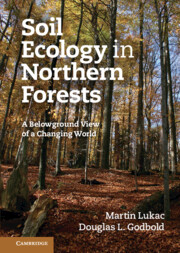Book contents
- Frontmatter
- Contents
- Preface
- 1 Introduction
- 2 Soil properties
- 3 Forest soil development and classification
- 4 Soil fungi
- 5 Soil water
- 6 Forest carbon cycle
- 7 Nutrient cycling
- 8 Northern forests in a high-CO2 world
- 9 Soil acidity and heavy metal pollution
- 10 Nitrogen
- 11 Soil functioning and climate change
- References
- Index
- Plate section
9 - Soil acidity and heavy metal pollution
Published online by Cambridge University Press: 26 April 2011
- Frontmatter
- Contents
- Preface
- 1 Introduction
- 2 Soil properties
- 3 Forest soil development and classification
- 4 Soil fungi
- 5 Soil water
- 6 Forest carbon cycle
- 7 Nutrient cycling
- 8 Northern forests in a high-CO2 world
- 9 Soil acidity and heavy metal pollution
- 10 Nitrogen
- 11 Soil functioning and climate change
- References
- Index
- Plate section
Summary
Soils of the humid temperate and northern forests tend to be acidic and high in organic carbon. In the past 100 years many of these soils, particularly in Europe and the northeastern USA, have been further acidified by the inputs of acid deposition, as well as by the effects of forest management. Although emissions of the main acidifying agent – suphur dioxide – from coal burning have largely been eliminated in Europe and North America, acid deposition in northern forests is still significant in developing countries, particularly China. Areas historically most affected by acidification are close to major sources of sulphur dioxide emissions, mainly because of the short-distance transport of this pollutant. Growing emissions and more effective dispersion technologies later combined to change the nature of acid deposition to one affecting regions or sub-continents, largely owing to increasing importance of long-distance transport. Alongside acidification, some of the affected forest soils have also been subjected to heavy metal deposition, leading to heavy metal accumulation within the soil profile. This chapter explains the principles and the mechanisms of soil acidification and heavy metal toxicity and discusses their effect on forest soil functioning.
Emission, transport and deposition of pollutants
The principal anthropogenic sources of acidity are emissions of sulphur and nitrogen into the atmosphere from combustion, in the form of sulphur dioxide (SO2) and oxides of nitrogen (NOX). These gases are then oxidised in the atmosphere to sulphuric (H2SO4) and nitric acid (HNO3) and are deposited into forests via precipitation, commonly termed acid rain.
- Type
- Chapter
- Information
- Soil Ecology in Northern ForestsA Belowground View of a Changing World, pp. 161 - 194Publisher: Cambridge University PressPrint publication year: 2011
- 1
- Cited by



